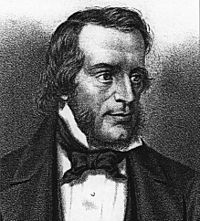Thomas Davis (Young Irelander) facts for kids
Quick facts for kids
Thomas Davis
|
|
|---|---|

Davis in the 1840s
|
|
| Born | 14 October 1814 Mallow, Ireland |
| Died | 16 September 1845 (aged 30) Dublin, Ireland |
| Occupation | Writer |
| Education | Arts degree |
| Alma mater | Trinity College, Dublin |
| Period | 1842–1845 |
| Literary movement | Young Ireland |
| Notable works | "The West's Asleep" "A Nation Once Again" |
Thomas Osborne Davis (born October 14, 1814 – died September 16, 1845) was an important Irish writer and leader. He helped start The Nation newspaper with Charles Gavan Duffy and John Blake Dillon. This newspaper became the voice of a group called the Young Ireland movement. Davis believed Ireland should have its own government. He also thought that Catholic and Protestant children should go to school together. He strongly supported the Irish language as Ireland's national language.
Contents
Early Life and Education
Thomas Davis was born on October 14, 1814, in Mallow, County Cork, Ireland. He was the youngest of four children. His father was a Welsh surgeon who died before Thomas was born. His mother was Irish and came from an old Irish family.
In 1818, his mother moved the family to Dublin. Thomas lived there until he passed away. He went to school in Dublin and then studied at Trinity College, Dublin. He earned a degree in Logic in 1835. After college, he studied law in London and Europe. He became a lawyer in 1838, but he never actually worked as one.
Beliefs About Irish Culture
Thomas Davis was a strong believer in what is called cultural nationalism. This means he thought that Ireland's unique culture, history, and language were very important. He looked back at old Irish traditions and stories for inspiration.
Davis was a Protestant, but he wanted all Irish people, no matter their religion, to unite. He was influenced by ideas that said a nation's identity comes from its climate, geography, and people's feelings.
In September 1842, he started The Nation newspaper with his friends. The newspaper was meant to support Daniel O'Connell's campaign to end the union with Britain. But Davis also used it to promote the Irish language and a strong Irish identity. He believed Ireland was a "rising" nation with its own special character.
In a speech in 1840, he clearly stated his belief in the Irish nation. He said that our country is where we are born, educated, and where our memories and hopes are. He believed that loving one's country is a natural part of being human.
Interestingly, Daniel O'Connell, another Irish leader, did not share Davis's strong views on the Irish language. O'Connell thought the English language was more useful for modern communication.
Disagreements with Daniel O'Connell
Davis supported O'Connell's group, the Repeal Association, which wanted to bring back an Irish Parliament in Dublin. However, they had some disagreements.
One big disagreement happened in 1845 over education. O'Connell was against new colleges that would teach Catholic and Protestant students together. He called them "godless." Davis, however, believed that if children were educated separately, they would live separate lives. He argued for "mixed" education. O'Connell accused Davis of being against Catholics. He started calling Davis and his friends "Young Irelanders," which was not a compliment.
They also disagreed on how to achieve Irish independence. O'Connell thought about accepting a "subordinate parliament," which would be an Irish law-making body with less power than a fully independent one. Davis didn't completely reject this idea. But while O'Connell looked for deals with the British Parliament, Davis tried to work with Protestant leaders in Ulster to find common ground.
His Early Death
Thomas Davis died suddenly in 1845 from scarlet fever. He was only 30 years old. Even though they had their differences, O'Connell was very sad about Davis's death. Davis was buried in Mount Jerome Cemetery in Dublin.
His Lasting Impact
Davis wrote many famous songs, including "The West's Asleep" and "A Nation Once Again". He also wrote for newspapers and started a history project that he couldn't finish because he died so young.
A statue of Thomas Davis was put up in College Green, Dublin, in 1966. The Irish president, Éamon de Valera, was there for the event.
His hometown of Mallow has a street named Davis Street, and there is a bronze statue of him there. One of the high schools in Mallow, Davis College, is also named after him.
Several Gaelic Athletic Association (GAA) clubs, which play Irish sports, are named after him. These include clubs in Tallaght, Dublin and Corrinshego, County Armagh.
Fort Davis, a fort at the entrance to Cork Harbour, is also named after him. There is also a Thomas Davis Street in Dublin 8.
Images for kids



